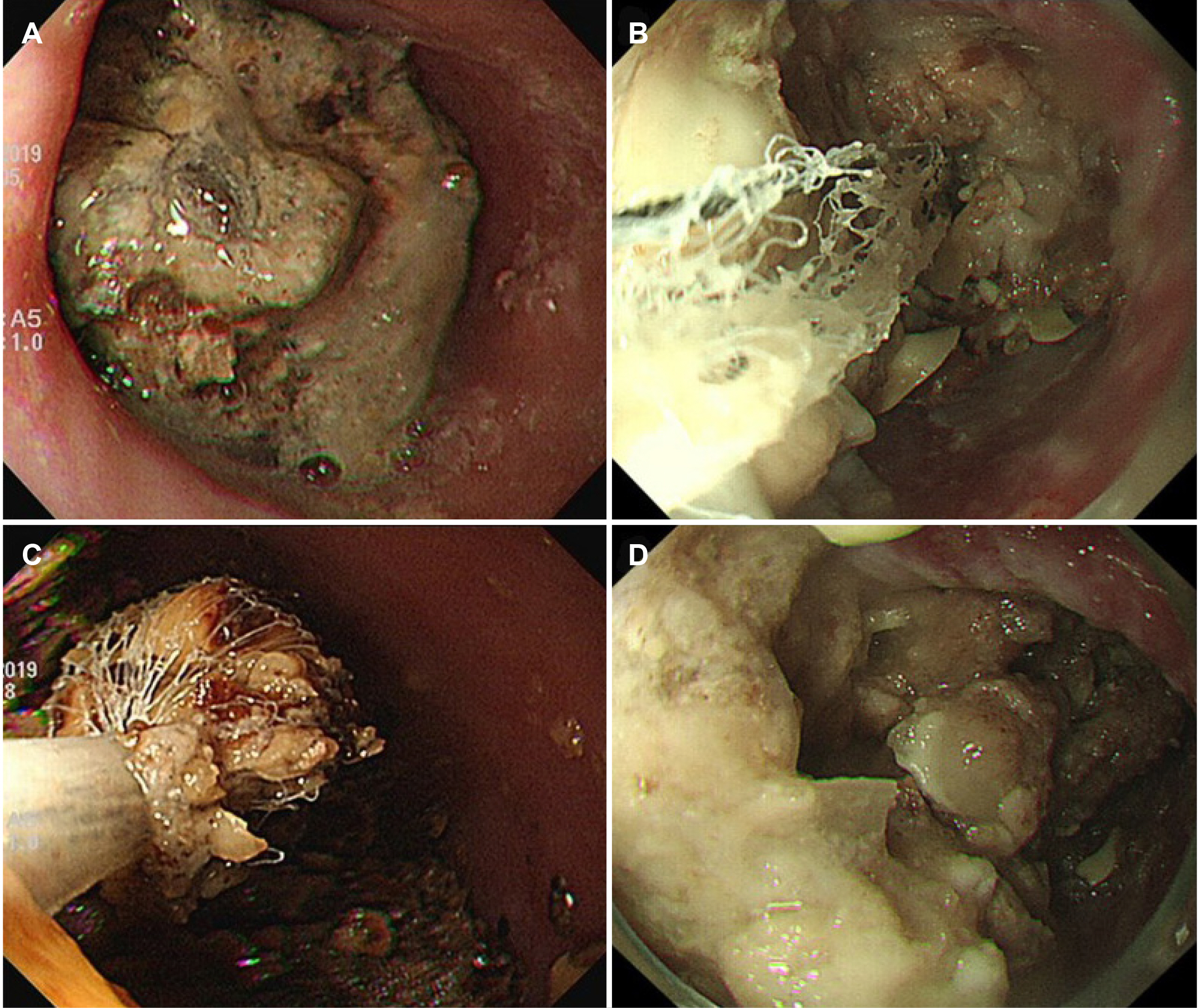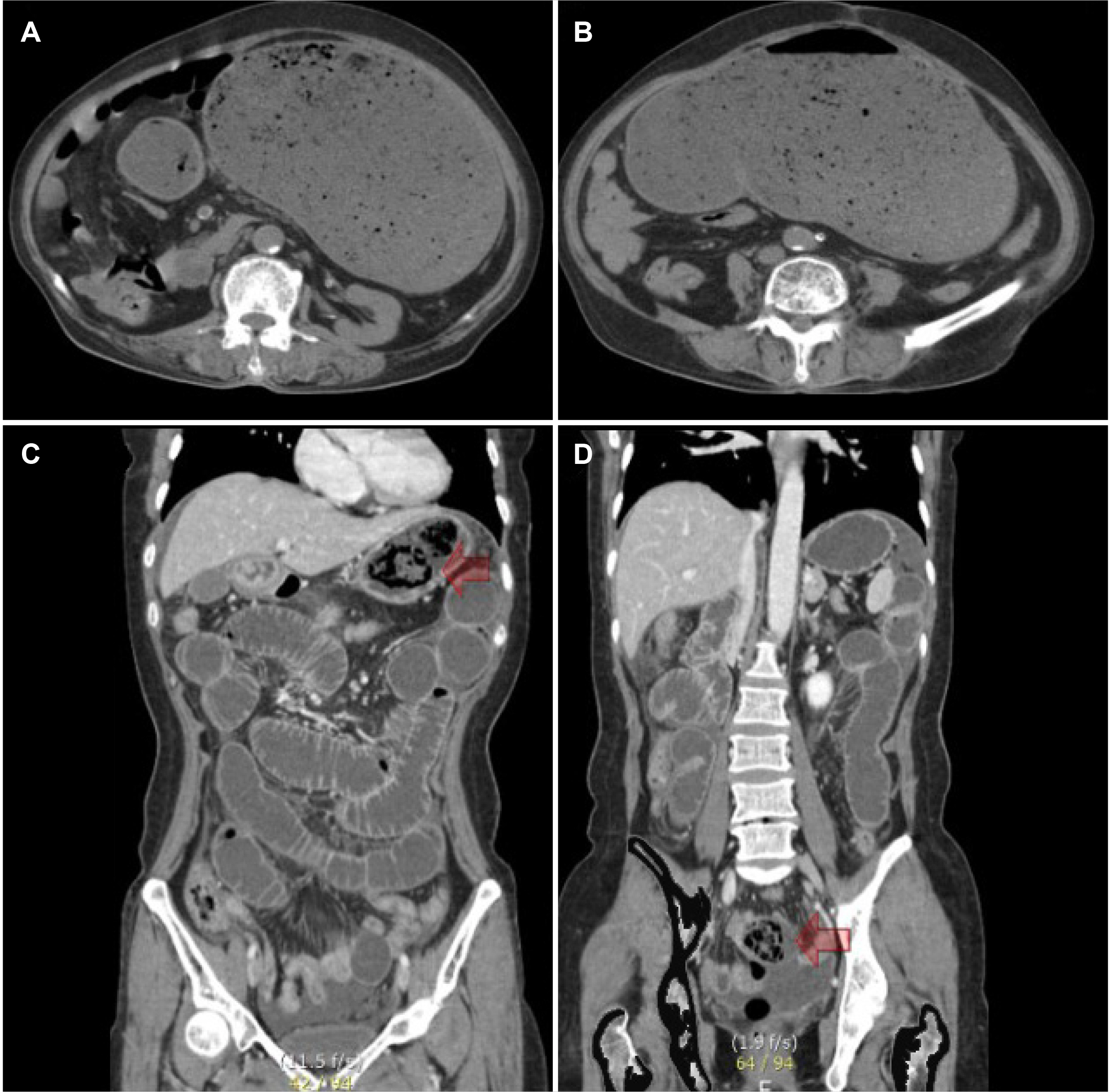Korean J Gastroenterol.
2023 Jun;81(6):253-258. 10.4166/kjg.2023.024.
A Single-center 12-year Experience of Patients with Gastrointestinal Bezoars
- Affiliations
-
- 1Department of Internal Medicine, Chonnam National Medical School, Gwangju, Korea
- KMID: 2543445
- DOI: http://doi.org/10.4166/kjg.2023.024
Abstract
- Background/Aims
Gastrointestinal (GI) bezoars are relatively rare diseases with clinical characteristics and treatment modalities that depend on the location of the bezoars. This study evaluated the clinical characteristics and treatment outcomes in patients with GI bezoars.
Methods
Seventy-five patients diagnosed with GI bezoars were enrolled in this study. Data were collected on the demographic and clinical characteristics and the characteristics of the bezoars, such as type, size, location, treatment modality, and clinical outcomes.
Results
Among the 75 patients (mean age 71.2 years, 38 males), 32 (42.6%) had a history of intra-abdominal surgery. Hypertension (43%) and diabetes (30%) were common morbidities. The common location of the bezoars was the stomach in 33 (44%) and the small intestine in 33 (44%). Non-surgical management, including adequate hydration, chemical dissolution, and endoscopic removal, was successful in 2/2 patients with esophageal bezoars, 26/33 patients with gastric bezoars, 7/9 patients with duodenal bezoars, and 20/33 patients with small intestinal bezoars. The remaining patients had undergone surgical management.
Conclusions
The management of GI bezoars requires multidisciplinary approaches, including the appropriate correction of fluid and electrolyte imbalances, chemical dissolution, and endoscopic and surgical treatments. (Korean J Gastroenterol 2023;81:253-258)
Keyword
Figure
Reference
-
1. Ahn YH, Maturu P, Steinheber FU, Goldman JM. 1987; Association of diabetes mellitus with gastric bezoar formation. Arch Intern Med. 147:527–528. DOI: 10.1001/archinte.1987.00370030131025. PMID: 3827430.
Article2. Mihai C, Mihai B, Drug V, Cijevschi Prelipcean C. 2013; Gastric bezoars--diagnostic and therapeutic challenges. J Gastrointestin Liver Dis. 224:111.3. Ghosheh B, Salameh JR. 2007; Laparoscopic approach to acute small bowel obstruction: review of 1061 cases. Surg Endosc. 21:1945–1949. DOI: 10.1007/s00464-007-9575-3. PMID: 17879114.
Article4. Park SE, Ahn JY, Jung HY, et al. 2014; Clinical outcomes associated with treatment modalities for gastrointestinal bezoars. Gut Liver. 8:400–407. DOI: 10.5009/gnl.2014.8.4.400. PMID: 25071905. PMCID: PMC4113045.
Article5. Iwamuro M, Okada H, Matsueda K, et al. 2015; Review of the diagnosis and management of gastrointestinal bezoars. World J Gastrointest Endosc. 7:336–345. DOI: 10.4253/wjge.v7.i4.336. PMID: 25901212. PMCID: PMC4400622.
Article6. Koulas SG, Zikos N, Charalampous C, Christodoulou K, Sakkas L, Katsamakis N. 2008; Management of gastrointestinal bezoars: an analysis of 23 cases. Int Surg. 93:95–98.7. Gökbulut V, Kaplan M, Kaçar S, Akdoğan Kayhan M, Coşkun O, Kayaçetin E. 2020; Bezoar in upper gastrointestinal endoscopy: A single center experience. Turk J Gastroenterol. 31:85–90. DOI: 10.5152/tjg.2020.18890. PMID: 32141815. PMCID: PMC7062142.8. Iwamuro M, Tanaka S, Shiode J, et al. 2014; Clinical characteristics and treatment outcomes of nineteen Japanese patients with gastrointestinal bezoars. Intern Med. 53:1099–1105. DOI: 10.2169/internalmedicine.53.2114. PMID: 24881731.
Article9. Kement M, Ozlem N, Colak E, Kesmer S, Gezen C, Vural S. 2012; Synergistic effect of multiple predisposing risk factors on the development of bezoars. World J Gastroenterol. 18:960–964. DOI: 10.3748/wjg.v18.i9.960. PMID: 22408356. PMCID: PMC3297056.
Article10. Paschos KA, Chatzigeorgiadis A. 2019; Pathophysiological and clinical aspects of the diagnosis and treatment of bezoars. Ann Gastroenterol. 32:224–232. DOI: 10.20524/aog.2019.0370.
Article11. Dikicier E, Altintoprak F, Ozkan OV, Yagmurkaya O, Uzunoglu MY. 2015; Intestinal obstruction due to phytobezoars: An update. World J Clin Cases. 3:721–726. DOI: 10.12998/wjcc.v3.i8.721. PMID: 26301232. PMCID: PMC4539411.
Article12. Qureshi SS. 2005; Esophageal bezoar in a patient with normal esophagus. Indian J Gastroenterol. 24:38.13. Kim KH, Choi SC, Seo GS, Kim YS, Choi CS, Im CJ. 2010; Esophageal bezoar in a patient with achalasia: case report and literature review. Gut Liver. 4:106–109. DOI: 10.5009/gnl.2010.4.1.106. PMID: 20479921. PMCID: PMC2871618.
Article14. Yaqub S, Shafique M, Kjæstad E, et al. 2012; A safe treatment option for esophageal bezoars. Int J Surg Case Rep. 3:366–367. DOI: 10.1016/j.ijscr.2012.04.008. PMID: 22609703. PMCID: PMC3376689.
Article15. Wang PY, Skarsgard ED, Baker RJ. 1996; Carpet bezoar obstruction of the small intestine. J Pediatr Surg. 31:1691–1693. DOI: 10.1016/S0022-3468(96)90052-4. PMID: 8986991.
Article16. Escamilla C, Robles-Campos R, Parrilla-Paricio P, Lujan-Mompean J, Liron-Ruiz R, Torralba-Martinez JA. 1994; Intestinal obstruction and bezoars. J Am Coll Surg. 179:285–288.17. Erzurumlu K, Malazgirt Z, Bektas A, et al. 2005; Gastrointestinal bezoars: a retrospective analysis of 34 cases. World J Gastroenterol. 11:1813–1817. DOI: 10.3748/wjg.v11.i12.1813. PMID: 15793871. PMCID: PMC4305881.
Article18. Yang S, Cho MJ. 2021; Clinical characteristics and treatment outcomes among patients with gastrointestinal phytobezoars: A single-institution retrospective cohort study in Korea. Front Surg. 8:691860. DOI: 10.3389/fsurg.2021.691860. PMID: 34250009. PMCID: PMC8263911.
Article



